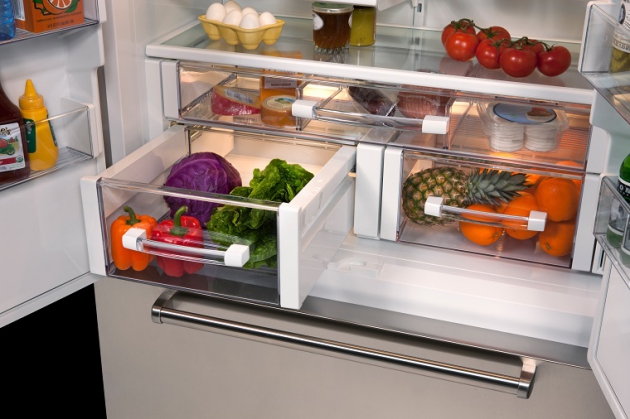The crisper drawer is one of the most overlooked features of a refrigerator. In many homes, these little drawers seem to be the dumping ground for anything from cans of beer and yogurts to kids’ treats. While a drawer may seem like a great place for these smaller items that don’t seem to have a place on the shelves, your crisper drawer actually serves an important role in keeping your food fresh. So, here we’ll explore how you can make the most of your crisper drawers.
The Crisper Drawer Basics
In basic terms, the crisper drawer is a sealed off area that is set to a higher or lower humidity than the rest of the refrigerator cavity. Some models of refrigerator feature several drawers with pre-set humidity levels, other refrigerators have drawers that allow you to manually adjust the humidity level as needed. This adjustment mechanism tends to be deceptively simple; a little vent in the drawer closes when you set it to high humidity, sealing the drawer shut. When the humidity is set lower, the vent is opened to allow some moisture trapped out of the drawer. What is a little more complicated is deciding what foods should go where.
What Should be Stored in Your Crisper Drawers
While you can keep anything in your crisper drawer, they are designed to keep your produce fresher for longer. When you’ve taken the time and money to shop at farmer’s markets or quality grocery stores, it is waste when those beautiful vegetables wilt or soften in only a day or two. Crisper drawers can provide the optimum conditions to help maintain those lovely organic vegetables and fruits to save your dinner plans and your wallet.
Unfortunately, it is not as simple as throwing all your produce in the crisper drawer, as different types of produce have different needs. Some vegetables need higher humidity, while others prefer lower humidity and putting these items in the wrong conditions can compromise their lifespan. The good rule of thumb is that items that rot need low humidity while wilting items need high humidity, but we’ll explore this in more detail now.
Low Humidity Items
Foods that rot as they go bad need to be kept in low humidity conditions to optimize their lifespan. Produce in this category emit gas as they ripen and age, so opening the crisper drawer vent allows the gas to escape to keep your items fresher for longer. Some examples of items that should be kept in low humidity conditions include peaches, grapes, apples, pears, and avocados.
High Humidity Items
Wilting vegetables and foods don’t release any gas as they are stored, but they are prone to losing moisture. This means that these items should be kept in a high humidity crisper drawer to maintain their freshness. These foods include broccoli, cucumbers, carrots, strawberries and leafy greens such as lettuce, spinach, and kale.
Keep The Drawers Full
Finally, if you want to get the most out of your crisper drawers, it is worth considering that they work best when they are almost full. Although you still want to allow some airflow around your items, you can pack your crisper drawer with fruits and veggies, and you’ll be surprised at how well they last in the right conditions. So, next time you’re at the farmer’s market, go a little crazy, just remember to eat all of them!
If your refrigerator lacks crisper drawers and you’re considering an upgrade, you can explore your options with this refrigerator collection or speak to a home appliance expert for further help and guidance.

